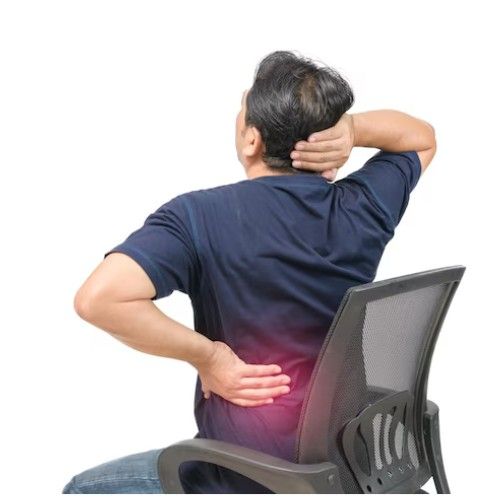This condition is characterized by pain radiating along the sciatic nerve from the lower back, sometimes through the hips, and down on one or both legs. Sciatica is known as ‘Gridhrasi’ in Ayurveda. According to Ayurveda, this is caused by an imbalance of the Vata dosha, the dosha controlling movement, and the nervous system. At times, there can be participation of Kapha dosha, which causes stiffness and heaviness.
Sciatica originates due to an unhealthy diet, unhealthy lifestyle, sitting for a long time, lifting anything heavy, or injuries that may exacerbate Vata and eventually cause compression or inflammation of nerves. Ayurveda treatment is dosha-based, balancing the doshas with alleviation from pain, reducing the inflammation, and targeting the root cause. The best ayurvedic medicine for sciatica pain is determined after proper consultation with the doctor and as per the course of treatment determined.
What Causes Sciatica?
Pinching of the sciatic nerve's nerve roots results in sciatica. The most common causes are either an overgrowth of bone, sometimes known as bone spurs, on the spinal bones or a herniated disk in the spine. Rarely, the nerve may be compressed by a tumor. The Ayurvedic medicine for sciatica pain is determined to the maximum extent by analyzing the causes behind the problem.
Also, extended periods of sitting can lead to the development of sciatica pain. Herniated disks are more common in people who sit a lot or don't move around much than in active people. Diabetes raises the risk of nerve damage by altering how the body uses blood sugar.

Best Ayurvedic Medicine for Sciatica Pain
1. Rasnasaptakam Kashayam
Considered one of the best ayurvedic medicines for sciatica pain, this herb has been specially developed to relieve nerve-related pain and inflammation. Its main ingredient, Rasna (Pluchea lanceolata), is known for its anti-inflammatory and Vata-pacifying properties. It reduces pain, stiffness, and limited range of motion associated with sciatica. The medicine for sciatica pain can be derived from this therapeutic herbal concoction.
2. Trayodashyan Guggul
Trayodashyan Guggul is a classic medicine for sciatica that is highly effective for sciatica and other nerve problems. It relieves inflammation, strengthens muscles and nerves, and restores mobility. It is especially effective for chronic sciatica symptoms.
3. Maharasnadi Kwas
This powerful herbal decoction is made by combining dashamula (herb with 10 roots) with rasna and other herbs. It reduces Vata-related pain and stiffness, making it an excellent treatment for sciatica and similar ailments.
4. Dashamularishta
Dashamularishta is a fermented herbal tonic rich in dashamula, which reduces inflammation and calms Vata dosha. Being one of the best medicines for sciatica pain, it provides long-term relief from sciatica pain while improving overall strength and mobility.
5. Yogaraj Guggulu
This herbal formulation is specially designed to treat Vata disorders including sciatica. It relieves pain, strengthens the nerves, and increases flexibility in the affected area.
6. Ashwagandha (Withania somnifera)
Ashwagandha is a rejuvenating herb that strengthens the nervous system, reduces stress, and promotes the healing of damaged nerves. It is also effective in improving mobility and reducing inflammation.
Ayurvedic Treatment for Sciatica Pain
In addition to herbal medicines, Ayurveda recommends certain therapies to relieve pain, particularly sciatica, while promoting healing and balancing the doshas. Along with medication for sciatica, other Ayurvedic treatments can also be used during the entire course of the sciatica treatment plan.
1. Abhyanga (Oil Massage)
Daily massage with medicated oils such as Mahanarayana Taila or Kottamchukkadi Taila helps to reduce Vata imbalance, improve blood circulation, and relieve neuralgia.
2. Kati Basti
In this therapy, warm medicated oil is held in a dough ring on the lower back for some time. It nourishes tissues, reduces inflammation, and relieves sciatica pain.
3. Pizichir (Oil Infusion Therapy)
This therapy involves rhythmically pouring warm herbal oil over the body. It induces deep relaxation, reduces Vata stimulation, and relieves sciatica pain. The Ayurvedic medicine for sciatica pain can be complemented with oil infusion therapy.
4. Basti (Medical Enema)
Basti therapy is the most effective Panchakarma treatment for Vata disorders. Herbal decoctions or medicated oils are administered rectally, helping to detoxify the colon and pacify Vata. This treats the root cause of sciatica.
5. Swedana (Steam Therapy)
Steam therapy uses herbal decoctions that improve blood circulation, reduce stiffness, and relieve pain in the lower back and legs.
Conclusion
Ayurveda offers a holistic technique for treating sciatica by addressing its root cause, Vata imbalance, and offering long-term healing. Herbal treatments using Trayodashang Guggulu, Rasnasaptakam Kashayam, and Dashamoolarishta, mixed with therapies like Abhyanga and Basti, provide sustainable comfort from sciatic aches. Adopting a Vata-pacifying diet, practicing yoga, and incorporating healthy lifestyle adjustments lead to better recovery. Consulting an Ayurvedic expert allows for the development of a customized treatment plan.




